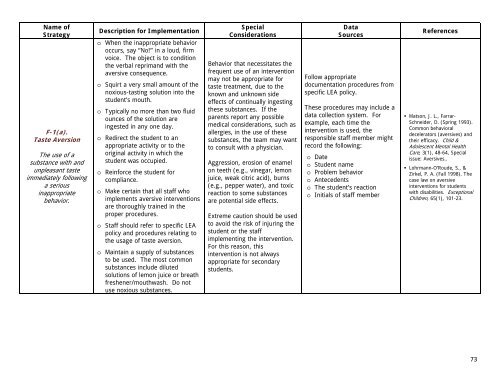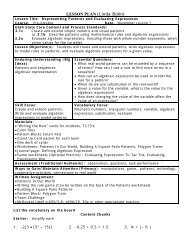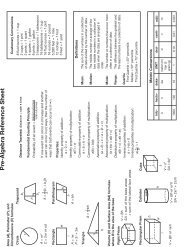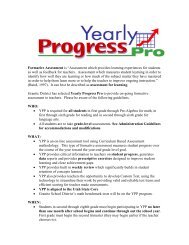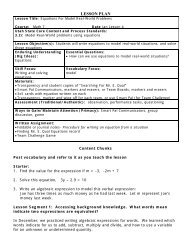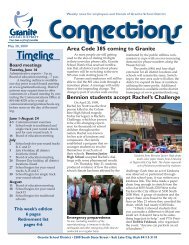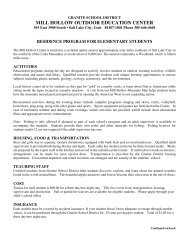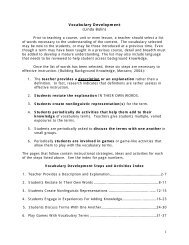Utah's Least Restrictive Behavioral Interventions Guidelines
Utah's Least Restrictive Behavioral Interventions Guidelines
Utah's Least Restrictive Behavioral Interventions Guidelines
You also want an ePaper? Increase the reach of your titles
YUMPU automatically turns print PDFs into web optimized ePapers that Google loves.
Name of<br />
Strategy<br />
F-1(a).<br />
Taste Aversion<br />
The use of a<br />
substance with and<br />
unpleasant taste<br />
immediately following<br />
a serious<br />
inappropriate<br />
behavior.<br />
Description for Implementation<br />
o When the inappropriate behavior<br />
occurs, say “No!” in a loud, firm<br />
voice. The object is to condition<br />
the verbal reprimand with the<br />
aversive consequence.<br />
o Squirt a very small amount of the<br />
noxious-tasting solution into the<br />
student’s mouth.<br />
o Typically no more than two fluid<br />
ounces of the solution are<br />
ingested in any one day.<br />
o Redirect the student to an<br />
appropriate activity or to the<br />
original activity in which the<br />
student was occupied.<br />
o Reinforce the student for<br />
compliance.<br />
o Make certain that all staff who<br />
implements aversive interventions<br />
are thoroughly trained in the<br />
proper procedures.<br />
o Staff should refer to specific LEA<br />
policy and procedures relating to<br />
the usage of taste aversion.<br />
o Maintain a supply of substances<br />
to be used. The most common<br />
substances include diluted<br />
solutions of lemon juice or breath<br />
freshener/mouthwash. Do not<br />
use noxious substances.<br />
Special<br />
Considerations<br />
Behavior that necessitates the<br />
frequent use of an intervention<br />
may not be appropriate for<br />
taste treatment, due to the<br />
known and unknown side<br />
effects of continually ingesting<br />
these substances. If the<br />
parents report any possible<br />
medical considerations, such as<br />
allergies, in the use of these<br />
substances, the team may want<br />
to consult with a physician.<br />
Aggression, erosion of enamel<br />
on teeth (e.g., vinegar, lemon<br />
juice, weak citric acid), burns<br />
(e.g., pepper water), and toxic<br />
reaction to some substances<br />
are potential side effects.<br />
Extreme caution should be used<br />
to avoid the risk of injuring the<br />
student or the staff<br />
implementing the intervention.<br />
For this reason, this<br />
intervention is not always<br />
appropriate for secondary<br />
students.<br />
Data<br />
Sources<br />
Follow appropriate<br />
documentation procedures from<br />
specific LEA policy.<br />
These procedures may include a<br />
data collection system. For<br />
example, each time the<br />
intervention is used, the<br />
responsible staff member might<br />
record the following:<br />
o Date<br />
o Student name<br />
o Problem behavior<br />
o Antecedents<br />
o The student’s reaction<br />
o Initials of staff member<br />
References<br />
• Matson, J. L., Farrar-<br />
Schneider, D. (Spring 1993).<br />
Common behavioral<br />
decelerators (aversives) and<br />
their efficacy. Child &<br />
Adolescent Mental Health<br />
Care, 3(1), 48-64, Special<br />
issue: Aversives..<br />
• Lohrmann-O’Roude, S., &<br />
Zirkel, P. A. (Fall 1998). The<br />
case law on aversive<br />
interventions for students<br />
with disabilities. Exceptional<br />
Children, 65(1), 101-23.<br />
73


